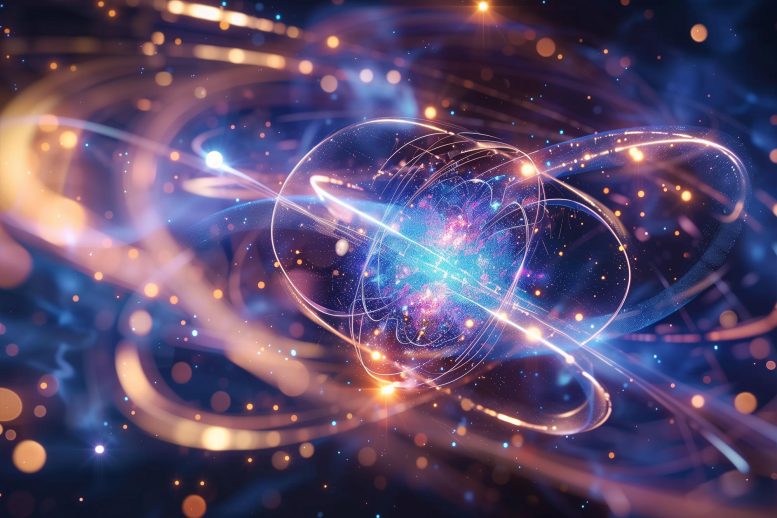
By U.S. Department of Energy October 3, 20243 Comments
Collected at: https://scitechdaily.com/scientists-detect-the-quantum-kick-from-a-single-nuclear-decay/
Scientists have devised a method to detect nuclear decay through the subtle movement of microparticles, enhancing our understanding of elusive particles like neutrinos.
This breakthrough paves the way for improved nuclear monitoring tools and could be enhanced by future quantum technologies.
Radioactivity is all around us, even in everyday items. For example, bananas contain trace amounts of radioactive potassium, with approximately 10 nuclei decaying every second in a typical banana. While these tiny amounts of radioactivity are not dangerous, there is growing scientific interest in enhancing the precision of tools for detecting such nuclear decays.
In new research, scientists have mechanically detected individual nuclear decays occurring in a microparticle (the size of a single grain of dust) for the first time. The study used a new technique. Rather than detecting the radiation emitted by the nuclei, the researchers measured the tiny “kick” to the entire microparticle that contained the decaying nucleus as the radiation escaped.

Advancements in Nuclear Decay Detection
These techniques can help us learn about particles emitted in nuclear decays that would otherwise be hard to detect. For example, the potassium decays in a banana emit particles called neutrinos that interact so weakly with matter that they escape undetected. One way to learn about these neutrinos is to see how much they kick the microparticle when they leave.
In addition, these techniques can identify radioactive material in a single dust particle. This could enable new tools for nuclear monitoring and nonproliferation. Finally, the ability to see these tiny kicks is ultimately limited by quantum mechanics and the Heisenberg uncertainty principle. In the future, quantum sensing techniques can further improve the method.
Utilizing Optical Tweezers in Quantum Sensing
In this work, researchers implanted radioactive lead-212 nuclei into silica microparticles with a diameter of approximately 3 microns. These microparticles were trapped in high vacuum at pressures of less than 10-10 atmospheres, to minimize noise from thermal fluctuations in the position of the microparticle. The researchers performed the trapping using a laser focused on the center of the vacuum chamber, which confines the microparticle to a small region near the laser focus (forming an “optical tweezer”). The researchers used the light scattered by the microparticle to image its position and look for any small jumps in the microparticle’s motion that could arise from nuclear decays.
The lead-212 decays produced further unstable daughter nuclei, which eventually decayed by emitting an alpha particle. When the alpha particles escaped the microparticles, two signatures were detected. First, the electric charge on the microparticle changed, which was detected with precision better than a single elementary charge. Second, the tiny recoil of the entire microparticle (more than a trillion times heavier than the alpha particle itself) could be detected.
Future Potential of Nanoparticle Detection
By scaling these same techniques to smaller nanoparticles, it will also be possible to detect the kick from a single beta, gamma, or neutrino exiting the sphere. Fundamental constraints on this measurement are imposed by quantum mechanics. Measurement of the nanoparticle position using light introduces noise, due to the fluctuations in the number of light quanta (“photons”) interacting with the nanoparticle. Quantum sensing techniques can eventually be used to surpass the corresponding “standard quantum limit” that applies to simultaneous measurements of the nanoparticle position and momentum. By employing squeezed light or similar methods to focus solely on measuring the particle’s momentum—despite the trade-off of increased noise in the position which is less critical — it’s possible to detect even smaller recoils.
References:
“Mechanical Detection of Nuclear Decays” by Jiaxiang Wang, T. W. Penny, Juan Recoaro, Benjamin Siegel, Yu-Han Tseng and David C. Moore, 8 July 2024, Physical Review Letters.
DOI: 10.1103/PhysRevLett.133.023602
“Searches for Massive Neutrinos with Mechanical Quantum Sensors” by Daniel Carney, Kyle G. Leach and David C. Moore, 8 February 2023, PRX Quantum.
DOI: 10.1103/PRXQuantum.4.010315

Leave a Reply